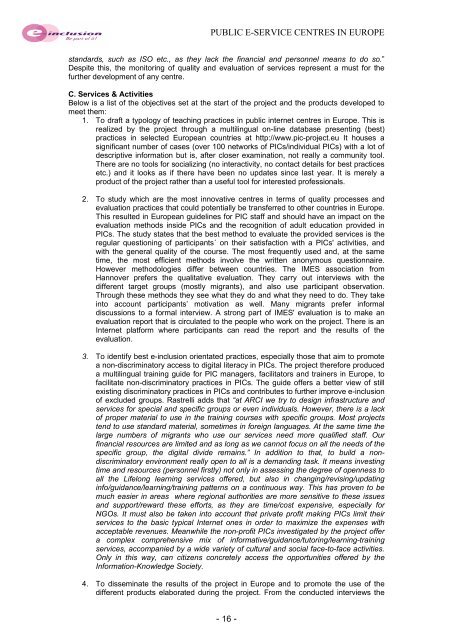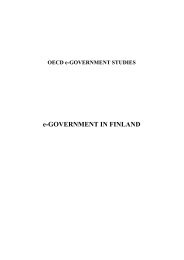Comparative Study of Public e-Service Centres in - ePractice.eu
Comparative Study of Public e-Service Centres in - ePractice.eu
Comparative Study of Public e-Service Centres in - ePractice.eu
Create successful ePaper yourself
Turn your PDF publications into a flip-book with our unique Google optimized e-Paper software.
PUBLIC E-SERVICE CENTRES IN EUROPE<br />
standards, such as ISO etc., as they lack the f<strong>in</strong>ancial and personnel means to do so.”<br />
Despite this, the monitor<strong>in</strong>g <strong>of</strong> quality and evaluation <strong>of</strong> services represent a must for the<br />
further development <strong>of</strong> any centre.<br />
C. <strong>Service</strong>s & Activities<br />
Below is a list <strong>of</strong> the objectives set at the start <strong>of</strong> the project and the products developed to<br />
meet them:<br />
1. To draft a typology <strong>of</strong> teach<strong>in</strong>g practices <strong>in</strong> public <strong>in</strong>ternet centres <strong>in</strong> Europe. This is<br />
realized by the project through a multil<strong>in</strong>gual on-l<strong>in</strong>e database present<strong>in</strong>g (best)<br />
practices <strong>in</strong> selected European countries at http://www.pic-project.<strong>eu</strong> It houses a<br />
significant number <strong>of</strong> cases (over 100 networks <strong>of</strong> PICs/<strong>in</strong>dividual PICs) with a lot <strong>of</strong><br />
descriptive <strong>in</strong>formation but is, after closer exam<strong>in</strong>ation, not really a community tool.<br />
There are no tools for socializ<strong>in</strong>g (no <strong>in</strong>teractivity, no contact details for best practices<br />
etc.) and it looks as if there have been no updates s<strong>in</strong>ce last year. It is merely a<br />
product <strong>of</strong> the project rather than a useful tool for <strong>in</strong>terested pr<strong>of</strong>essionals.<br />
2. To study which are the most <strong>in</strong>novative centres <strong>in</strong> terms <strong>of</strong> quality processes and<br />
evaluation practices that could potentially be transferred to other countries <strong>in</strong> Europe.<br />
This resulted <strong>in</strong> European guidel<strong>in</strong>es for PIC staff and should have an impact on the<br />
evaluation methods <strong>in</strong>side PICs and the recognition <strong>of</strong> adult education provided <strong>in</strong><br />
PICs. The study states that the best method to evaluate the provided services is the<br />
regular question<strong>in</strong>g <strong>of</strong> participants´ on their satisfaction with a PICs' activities, and<br />
with the general quality <strong>of</strong> the course. The most frequently used and, at the same<br />
time, the most efficient methods <strong>in</strong>volve the written anonymous questionnaire.<br />
However methodologies differ between countries. The IMES association from<br />
Hannover prefers the qualitative evaluation. They carry out <strong>in</strong>terviews with the<br />
different target groups (mostly migrants), and also use participant observation.<br />
Through these methods they see what they do and what they need to do. They take<br />
<strong>in</strong>to account participants’ motivation as well. Many migrants prefer <strong>in</strong>formal<br />
discussions to a formal <strong>in</strong>terview. A strong part <strong>of</strong> IMES' evaluation is to make an<br />
evaluation report that is circulated to the people who work on the project. There is an<br />
Internet platform where participants can read the report and the results <strong>of</strong> the<br />
evaluation.<br />
3. To identify best e-<strong>in</strong>clusion orientated practices, especially those that aim to promote<br />
a non-discrim<strong>in</strong>atory access to digital literacy <strong>in</strong> PICs. The project therefore produced<br />
a multil<strong>in</strong>gual tra<strong>in</strong><strong>in</strong>g guide for PIC managers, facilitators and tra<strong>in</strong>ers <strong>in</strong> Europe, to<br />
facilitate non-discrim<strong>in</strong>atory practices <strong>in</strong> PICs. The guide <strong>of</strong>fers a better view <strong>of</strong> still<br />
exist<strong>in</strong>g discrim<strong>in</strong>atory practices <strong>in</strong> PICs and contributes to further improve e-<strong>in</strong>clusion<br />
<strong>of</strong> excluded groups. Rastrelli adds that “at ARCI we try to design <strong>in</strong>frastructure and<br />
services for special and specific groups or even <strong>in</strong>dividuals. However, there is a lack<br />
<strong>of</strong> proper material to use <strong>in</strong> the tra<strong>in</strong><strong>in</strong>g courses with specific groups. Most projects<br />
tend to use standard material, sometimes <strong>in</strong> foreign languages. At the same time the<br />
large numbers <strong>of</strong> migrants who use our services need more qualified staff. Our<br />
f<strong>in</strong>ancial resources are limited and as long as we cannot focus on all the needs <strong>of</strong> the<br />
specific group, the digital divide rema<strong>in</strong>s.” In addition to that, to build a nondiscrim<strong>in</strong>atory<br />
environment really open to all is a demand<strong>in</strong>g task. It means <strong>in</strong>vest<strong>in</strong>g<br />
time and resources (personnel firstly) not only <strong>in</strong> assess<strong>in</strong>g the degree <strong>of</strong> openness to<br />
all the Lifelong learn<strong>in</strong>g services <strong>of</strong>fered, but also <strong>in</strong> chang<strong>in</strong>g/revis<strong>in</strong>g/updat<strong>in</strong>g<br />
<strong>in</strong>fo/guidance/learn<strong>in</strong>g/tra<strong>in</strong><strong>in</strong>g patterns on a cont<strong>in</strong>uous way. This has proven to be<br />
much easier <strong>in</strong> areas where regional authorities are more sensitive to these issues<br />
and support/reward these efforts, as they are time/cost expensive, especially for<br />
NGOs. It must also be taken <strong>in</strong>to account that private pr<strong>of</strong>it mak<strong>in</strong>g PICs limit their<br />
services to the basic typical Internet ones <strong>in</strong> order to maximize the expenses with<br />
acceptable revenues. Meanwhile the non-pr<strong>of</strong>it PICs <strong>in</strong>vestigated by the project <strong>of</strong>fer<br />
a complex comprehensive mix <strong>of</strong> <strong>in</strong>formative/guidance/tutor<strong>in</strong>g/learn<strong>in</strong>g-tra<strong>in</strong><strong>in</strong>g<br />
services, accompanied by a wide variety <strong>of</strong> cultural and social face-to-face activities.<br />
Only <strong>in</strong> this way, can citizens concretely access the opportunities <strong>of</strong>fered by the<br />
Information-Knowledge Society.<br />
4. To dissem<strong>in</strong>ate the results <strong>of</strong> the project <strong>in</strong> Europe and to promote the use <strong>of</strong> the<br />
different products elaborated dur<strong>in</strong>g the project. From the conducted <strong>in</strong>terviews the<br />
- 16 -
















